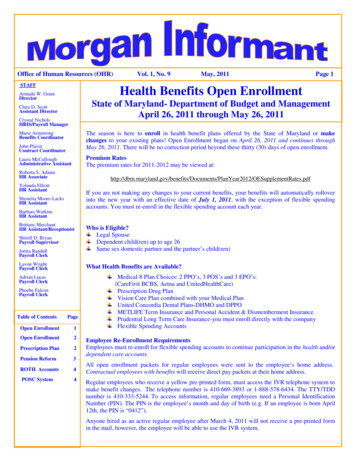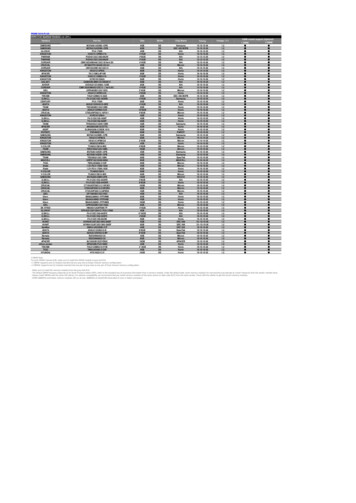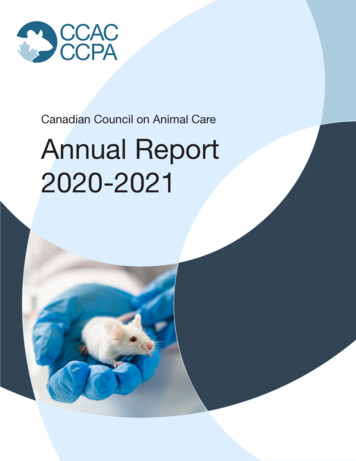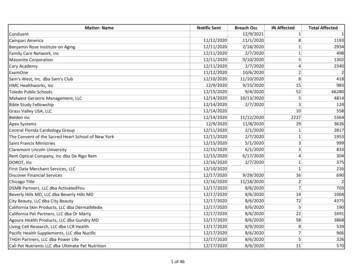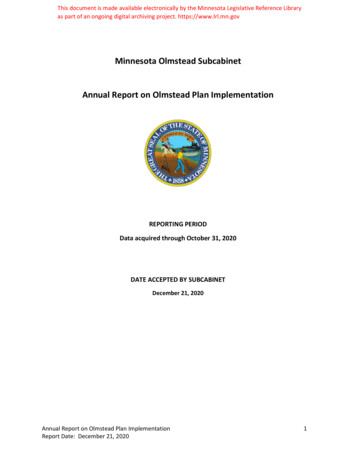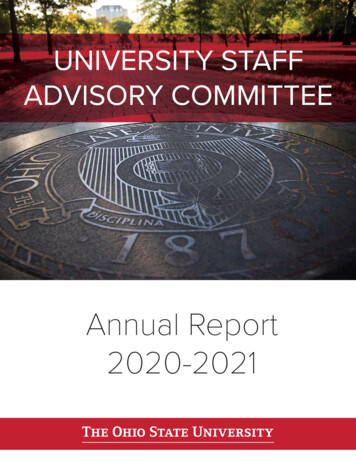
Transcription
UNIVERSITY STAFFADVISORY COMMITTEEAnnual Report2020-2021
Table of ContentsExecutive Summary . 3USAC Recommendations . 4Updates from 2019 - 2020 RecommendationsDirect Impact to Staff. 6USAC Multi-Year PlanExecutive CommitteeStaff AffairsGovernanceInclusive ExcellenceOutreach and EngagementWellness Task ForceUSAC University Partners . 37USAC Roster . 40Appendices . 41Appendix A: Winter Recess ProposalAppendix B: 2020 Tuition Data SummaryAppendix C: 2017-2018 USAC Annual ReportAppendix D: Rewards and Recognition InfographicAppendix E: Flex Work Toolkit OverviewAppendix F: Ombudsman BenchmarkingAppendix G: Staff Senator Update for USACAppendix H: Staff Career Development Grant Analysis, 2020 ReportAppendix I: Staff Development Grants 2020-2021Appendix J: EEF Applications Report Fiscal Year 2019-2020Appendix K: EEF Applications Report Mid-Fiscal Year 2020-2021Appendix L: Historical USAC Application Review 2015-2020Appendix M: ERG Conversation Survey Results2
Executive SummaryDate:April 21, 2021From:University Staff Advisory Committee (USAC), 2020-2021Chrissy Sprouse, ChairSteven Loborec, Chair-ElectLaurel Van Dromme, Vice-Chair Secretary/TreasurerShea Ryan, Vice-Chair CommunicationsTo:Dr. Kristina M. Johnson, President, The Ohio State UniversitySubject:University Staff Advisory Committee (USAC) 2020-21 Annual ReportThe 2020-21 year for the University Staff Advisory Committee (USAC) has beenproductive, transparent, adaptable, and most importantly intentional. During a year inwhich many of us never expected by facing challenges of a global pandemic, USAC notonly continued existing partnerships but also created new partnerships with a variety ofkey leaders, University initiatives and staff to advance the mission of the University.USAC is appreciative for the plethora of opportunities to engage positively withPresident Johnson and other leaders across the enterprise.As the President’s staff advisory committee, USAC is dedicated to positively advocatingon behalf of staff while continuing to deliver on our multi-year plan that was establishedin 2017. The consistency in our vision and focus over the past four (4) years not onlystrengthens our efforts and progress but also provides transparency in our initiativesand focus to the university community. Many of our triumphs have been due to thestrength of our four (4) subcommittees and their ability to strategically think on a widerange of initiatives of ways to enhance the staff experience. Their dedication to thework of USAC is paramount to the success of our advocacy.Fiscal year (FY) 2021 has marked a challenging year for all as we continued to adjust toour changing environments and the University’s response to the COVID-19 pandemic.Our mission was more critical than ever as we continued to engage with leadership andadvocate on behalf of staff.The 2020-21 USAC Annual Report offers updates and closures on recommendationsmade previously, including the Winter Recess Proposal. The report highlights the waysin which USAC fostered meaningful staff engagement through our advocacy work andoutreach.3
Updates from 2019 - 2020 RecommendationOver the years, USAC has made recommendations to senior leaders regarding keyinitiatives. The work required to fully implement USAC recommendations can takeseveral months. Below is a status update to the recommendation made from the2019-20 USAC Annual Report.Winter RecessBackgroundIn 2019, USAC proposed the addition of three floating holidays as a low cost, highimpact benefit to staff. USAC spent the year collecting time-off benefit data fromtwenty-six (26) peer institutions, institutions across the Big 10, and large localcorporations that Ohio State must compete with for talent. A summary of thebenchmarking conducted are available in Appendix A: Winter Recess Proposal.USAC’s recommendation is for an academic core closure at The Ohio State Universitybeginning on December 24th and running through January 2nd allowing employees tohave an extended period of time off. The proposed name for the closure is “WinterRecess”.If adopted, Winter Recess would become part of Ohio State’s ongoing efforts to fulfillthe strategic plan with a specific emphasis on “Operational Excellence and ResourceStewardship”. Pillar V states that “Ohio State will be an exemplar of best practices inresource stewardship, operational effectiveness, and efficiency and innovation”. Byclosing non-essential functions during this time period, Ohio State will improve resourcestewardship, operational effectiveness and efficiency by: Demonstrating an increase in energy cost savings Increasing efficiency and productivity Improving staff morale and mental health Improving recruiting and retention efforts Linking with the Ohio State’s Wellness InitiativeKey AccomplishmentsBenchmarking and significant research were conducted on implementing a WinterRecess at the University in 2020. Research indicated that providing a shutdown periodduring the holiday season not only supported wellness initiatives but also providedsustainability advantages. Benchmarking revealed that most Big 10 universities shutdown during the holiday season. The Winter Recess Proposal was presented toPresident Michael V. Drake in April 2020 prior to his departure along with various seniorleaders throughout the course of 2019-20. The proposal was introduced forconsideration with the knowledge that certain issues needed clarified prior to initiation.Dr. Drake was supportive of continuing to investigate the potential of a Winter Recess.Due to the implications of COVID-19 and the initiation of Workday, it was decided toplace the initiation of Winter Recess on hold for 2020. In the Fall of 2020, members ofStaff Affairs began to answer questions presented by Dr. Drake and senior leadershipthat needed clarified, including the following questions:4
Updates from 2019 - 2020 Recommendation1. Do we need a separate set of guidelines for the Health System?2. Who is considered “Essential Staff” and will be required to work duringWinter Recess?3. How will staff be paid during Winter Recess? This depends on whetherthe staff member is exempt or non-exempt; essential or non-essential.4. Do temporary and student employees receive pay for Winter Recess?5. If an employee is on unpaid FMLA, would the employee be allowed tochange the designation of FMLA and be compensated for Winter Recess?6. Can essential personnel who work/are scheduled to work during WinterRecess re-designate their time off prior to Winter Recess?7. What are the financial implications of providing staff with additional paidtime off?8. What impact will this have on the regional campuses with sharedresources?In order to discuss these lingering issues, meetings were conducted with pertinent units,including Medical Center Human Resources, Office of Legal Affairs, as well as regionalcampuses.Work RemainingIn order to fully address remaining questions, meetings continue to occur with thefollowing constituents: Office of Human ResourcesRegional Campuses to discuss regional campus impactsBusiness and Finance to discuss financial implicationsCentral Ohio Technical College (COTC) to discuss potential impacts for costshared appointmentsOffice of Student Life to discuss impacts to staff due to students remainingon campusFacilities Operations and Development (FOD) to discuss implications tobuildings remaining open during this timeWhen meeting with the Office of Legal Affairs, it was suggested that a policy be inplace prior to implementing Winter Recess. Research related to policy development willalso need completed. Once outstanding issues are clarified, a document withfrequently asked questions will be drafted as well as proposed language updates to thePaid Time Off Policy (6.27). USAC would like to propose a Winter Recessimplementation of Winter 2021.Appendix A: Winter Recess Proposal5
Direct Impact to Staff - USAC Multi-Year PlanUSAC is committed to frequent engagement with staff and maintaining a consistentvoice advocating on behalf of staff. The chart below summarizes key initiatives and focusareas for 2020-21. These areas align with the pillars of USAC’s multi-year plan to helpcultivate our mission. The intent is to update this plan quarterly to ensure our focus isaligned with the University’s and HR’s strategic plans as well as key University initiatives. Continue to prioritize our efforts in the four existing subcommittees: Governance,Inclusive Excellence (IE), Outreach and Engagement (O&E), and Staff Affairs (SA) Focus on diversity and inclusion to create a culture of equity for staff across theUniversity Cultivate relationships with key leaders to represent the needs of staff Enhance our involvement with the Enterprise Project, Career Roadmap, SharedValues Initiative, as well as other University-wide initiatives Increase and maintain staff presence in University governance Increase collaboration with staff advocacy groups across the university as well asthe Big Ten Academic AllianceThis chart emphasizes USAC key initiatives and activities that are a priority to USAC.6
Direct Impact to Staff - Executive CommitteePreparing Staff for ChangeAs the University continued progress towards the implementation of HR Transformationand the Enterprise Project, it has been paramount for USAC to support these initiativesand prepare staff for change especially during these unprecedented times. During thistime of organizational, procedural, and budgetary change coupled with a pandemic andsocietal injustices, emotions of fear and uncertainty were heightened across theuniversity. To lead staff through change, USAC increased communication efforts oninformation pertaining to University initiatives as well as partnered with variousconstituents across campus to support or highlight information, initiatives and/or eventsrelevant to staff. In addition, USAC continued to foster relationships with local andregional Staff Advisory Committees (SACs) by attending virtual committee meetings.These committees are the heart of thecolleges and units and because ofthis, have a pulse on staff concernsand morale. Information shared withinthese meetings was communicated toUniversity leadership, as appropriate,to aid in communication efforts towardchange. With USAC having anincreased on-line presence in FY21there was a tremendous importance inhaving a consistent output ofcommunication efforts.145318.1% Newslettersubscriberincrease56612307.6% followerincrease1003FY21FY2010545% followerincrease5265104% followerincrease490Furthermore, USAC sought to amplify messaging of various campus partners wheneverpossible in order to keep staff engaged on any changes taking place at the University.By maintaining a focus on USAC’s communication efforts, FY21 saw positive growth insubscribers and engagement over our various virtual platforms, which USAC projects tocontinue into the next fiscal year.Aside from attending SAC meetings and increased USAC communication to staff, USACalso hosted a Local and Regional SAC Retreat on Friday, April 9, 2021 via Zoom, which isthe first time that all campuses were present at a USAC retreat and included forty-two(42) attendees. Speakers and topics included: Bern Melnyk, University Chief Wellness Officer and Dean, College of Nursingdiscussed the importance of wellness in addition provided an update regardingthe Return to Campus Survey results Gates Garrity-Rokous, Vice President and Chief Compliance Officer, and KimPotter, Director of Policy and Engagement, The Office of University Complianceand Integrity provided an overview of the Shared Values Initiative (SVI) Molly Peirano, Interim Title IX Coordinator, Office of Institutional Equityprovided an overview of the office as well as updates to the Title IX policy Tom Gessells, Director of Informational Technology, OSU Health Plan and StaffSenator provided an overview of University Senate as well as the Staff Senatorrole7
Direct Impact to Staff - Executive CommitteeBreakout discussions were facilitatedby USAC members and addressedtopics mentioned above. Local andRegional SAC members contributedto robust and meaningfulconversations that sparkedadditional dialogue with presentersthat will initiate more concretepartnerships across the university aswork continues on these importantinitiatives. USAC’s InclusiveExcellence and Staff Affairssubcommittees also facilitatedlistening sessions to provide updates on current initiatives and to hear of potential gaps inadvocacy efforts. Overall, Local and Regional SAC members felt that their voices wereheard, appreciated the dialogue with leadership, and are eager to support these initiativesmoving forward within their perspective campuses/colleges/units.Communication efforts are not limited toexternal constituents to USAC, USAC alsofocused internally within the committee tocreate a cohesive environment as it wasevident that we would not be meeting inperson this year. Members received“USAC Weekly Updates” from the USACchair which contained updates in regardsto University initiatives, highlights fromUniversity leadership and committeemeetings, status updates on USACinitiatives as well as general informationin relation to staff. In addition, USACmembers were spotlighted throughoutthe course of the year to learn moreabout each other and were provided monthly opportunities to virtually engage via Zoomduring USAC Hang Out sessions.Advocacy EffortsIn a year of COVID-19 and societal injustices, the University formed multiple task forcesfocused on these important topics. As task forces formed, USAC leadership ensured a staffrepresentative was a part of these important conversations. Because of our consistentapproach at ensuring staff are present, a USAC member was added to the Public SafetyAdvisory Committee which is a new University committee within the Department of PublicSafety.8
Direct Impact to Staff - Executive CommitteeWhile preparing for returning to campus in the fall, the Office of Academic Affairs andthe Office of Human Resources formed multiple task forces around various topics suchas academic transition, benefits, leave, and policy updates. During discussions, USACmembers consider any potential impacts to staff and discuss alternate solutions, ifpossible. USAC also partnered with various task forces across campus such as theTask Force on Racism and Racial Inequities and the Task Force on Community Safetyand Well-Being to ensure our efforts aligned with the work of these task forces.In addition to ensuring staff representation on University committees and task forces,USAC looks at University processes to see where staff presence is missing. In doing so,USAC partnered with Bruce McPheron, Executive Vice President and Provost, and KayWolf, Senior Vice Provost, to ensure that a staff member was not only a part of thesearch committee for Dean appointments but now a staff member will be a part of theDean’s Reappointment Review Process.During 2020-2021, University leadership changes were announced which led to theformation of several search committees. Of these national searches, USAC membersand Staff Senators have the privilege to serve on the following search committees:USAC/Staff SenatorSearch CommitteeChrissy Sprouse, ChairExecutive Vice President and ProvostSteven Loborec, Chair-elect Sr. Vice President of Talent, Culture and Human ResourcesAndrew Jordan, Staff Senator Vice President and Chief Information OfficerTo ensure the staff perspective was heard, a listening session was conducted inconjunction with Gene Smith, Senior Vice President and Wolfe Foundation EndowedAthletics Director, on March 15, 2021 regarding the Executive Vice President and Provostposition. Forty-five (45) current and former USAC members and Staff Senators providedvaluable insight on the qualities and traits that the search committee should consider asit relates to staff and the University at-large. The feedback provided was well received bysearch committee co-chairs Dr. Susan Olesik, Divisional Dean of Natural andMathematical Sciences and Distinguished University Professor and Dr. Grace Wang,Executive Vice President for Research, Innovation and Knowledge Enterprise, andshared with the search committee.Throughout the course of this unprecedented academic year, USAC’s advocacy effortswere more important than ever. Through various channels, staff contacted USAC tovoice concerns or provided feedback on numerous topics such as: COVID-19, Workday,tuition assistance benefit changes, mental health, retirement impacts for staff who teach,parking, and returning to campus. As concerns and feedback were received, USACworked with university leadership and were able to advocate for the following changes:9
Direct Impact to Staff - Executive CommitteeReversal of the tuition assistance benefits change. Maximum number of credithours remain unchanged at ten (10) credit hours Addition of salary ranges to job postings for campus staff and bi-weeklypositions in Workday Deepened discussions among leadership in regards to COVID-19 cases oncampus Extension of the exception to the use of accrued vacation over theestablished maximum carryover from Dec 31, 2020 to June 30, 2021. Thisextension provides employees flexibility until their next anniversary to utilizeaccrued vacation over the maximumIn addition, USAC partnered with Lin Hillis, Associate Vice President Talent, Leadershipand Diversity, and Erica Banta, Talent Management Director, within the Office of HumanResources to create additional professional development opportunities for staff. As ofmid-May 2021, staff will have access to thousands of resources through LinkedInLearning, an on-demand learning solution designed to help gain new skills and advancetheir career. With a one (1) year LinkedIn Learning subscription, staff will obtain: Unlimited access. Choosing from more than 5,000 video tutorials coveringbusiness, creative and technology topicsRelevant recommendations. Exploring the most in-demand skills based oninterestExpert instructors. Learning from industry leaders, all in one placeAppendix B: 2020 Tuition Data Summary10
Direct Impact to Staff - Staff AffairsThe Staff Affairs Subcommittee (SA) is responsible for engaging with policies anduniversity initiatives and promoting equity for staff. This is accomplished through datacollection, education, and partnerships with organizations across the university. Thetopics addressed include, but are not limited to, staff benefits, career progression, andhealth and wellness.USAC Member NameSandy Otis, ChairStaff RoleAsset Business AnalystInterim Sr Dir, Risk Mgmt &Stacey Houser, Vice-ChairChief Risk OfficerTina BogacSenior Director, EHSBrittany CrallBusiness Manager 2Research CommonsHolly DavisServices CoordAssociate Editor, StrategicJacob HollarCommunicationsFaith KlineAdministrative DirectorJustin LahmersQuality Improvement SpecialistCollege/UnitBusiness & FinanceBusiness & FinanceAdministration & PlanningOffice of Student LifeUniversity LibrariesOffice of StudentAcademic SuccessComprehensive Cancer CtrOffice of ResearchIn 2020, at the request of the USAC Executive Committee, Staff Affairs assessed workon many goals and initiatives from previous years. As a result, Staff Affairs identified thefollowing goals that would drive much of the subcommittee work throughout 2020-21: Winter Recess Rewards & Recognition Flexible and Remote Work Staff OmbudsmanREWARDS & RECOGNITIONBackgroundResearch shows that praise and commendation from managers was rated the topmotivator for performance, beating out other non-cash and financial incentives, by 67%of workers1. As noted in the 2017-18 USAC Annual Report, the resolution to the Rewardsand Recognition Task Force was to maintain status quo with university-wide eventsmanaged by OHR.During 2018-19, USAC collected feedback from units across campus related to staffawards and recognition offered at the unit and department level. Information collectedhelped guide conversations around integrating recognition activities at a grassroots levelin order to promote a culture of recognition university-wide. USAC designed a “6 EasyWays to Appreciate Your Team” infographic to encourage units and managers topromote rewards and recognition activities within their unit. This infographic suggestedhigh impact, low-cost ways that unit-level managers and staff can incorporate rewardsand recognition into their daily practices.1“Motivating People: Getting beyond Monday, 2009”Appendix C: 2017-18 USAC Annual ReportAppendix D: Rewards & Recognition Infographic11
Direct Impact to Staff - Staff AffairsKey AccomplishmentsBuilding from the rewards and recognition work completed in 2018-19, Staff Affairsexplored implementing a university-wide staff recognition program. The goal was tohighlight employees that strive to bring out The Ohio State University best practices inothers, someone who excels as an individual employee and team player and makes animpact in The Ohio State University community.Staff Affairs researched current programs among various colleges and business units toensure this program would be unique to the community. Through research and muchdiscussion, Staff Affairs implemented a monthly USAC Staff in the Spotlight, in whichcommunication efforts launched in December 2020. Each month, USAC makes a call fornominations from the University community to nominate a staff member that fulfills thekey qualities, traits, and characteristics that demonstrate excellence and have an impact.Essentially, nominating a staff member who exemplifies going above and beyond.Once a nomination is received, Staff Affairs members utilize a rubric to consistentlyevaluate the nominations based on answers to the following three questions: Why does the employee deserve to be a USAC Staff Spotlight? How does the nominee demonstrate excellence for The Ohio State University? What is the impact the employee has at The Ohio State University?The two (2) individuals with the highest scores are selected to be featured as thecurrent month’s USAC Staff in the Spotlight. However, before selected staff arenotified, Staff Affairs confirms with partners in OHR that these staff members are in goodstanding within their roles and the university. Once confirmed, a brief ‘get to know you’email is sent to the selected nominees in which answers will be used in the ‘StaffSpotlight’. The final recognition will be in the monthly USAC Newsletter as well as otherUniversity communications.As of the beginning of April 2021, USAC is pleased that eighteen (18) nominations fromacross the university were received with four (4) staff members being spotlighted.12
Direct Impact to Staff - Staff AffairsNext StepsEach month, Staff Affairs will continue to work with communication partners to promotenominations of staff members specifically focusing on under-represented groups oncampus and to ensure diversity is exhibited among nominations including roles withincampuses/colleges/departments/units.FLEXIBLE WORK REMOTE WORKBackgroundThe current Flexible Work policy (6.12) has been in place at Ohio State since 2011. Asstated in the policy:“Workplace flexibility provides a way to successfully manage people, time,space, and workload. The university supports flexible work arrangements toachieve a highly productive work environment that enables staff to balancework and personal needs while providing workforce predictability and stability.Workplace flexibility is a strategy for using resources most efficiently andproviding the best environment for talent.”While the policy is clear about the possibility of and benefits to a flexible workingarrangement, the execution of this policy is inconsistently applied throughout theUniversity. To address this gap, USAC and the President and Provost’s Council onWomen (PPCW) began collaborations in Autumn 2018 which ultimately resulted in thecreation of a Flex Work Toolkit, a valuable resource that managers and employees canutilize when having conversations around flex work. The toolkit is housed on the USACwebsite and includes the following resources: Flex Work Power Point, to provide an overview of the policyFlex Work Scenarios, to help employees better understand the possibleapplication of the policy to their specific situations“How to Discuss Flex Work with Your Manager” guide, to discusscommunication strategies, performance tools, and negotiation tips to helpset up a flexible work arrangementFlex Work Spotlight video, to highlight the successes of individuals and unitswho have successfully implemented flexible work arrangementsAppendix E: Flex Work Toolkit OverviewKey AccomplishmentsIn 2020, COVID-19 impacted the University community and current in-person worksettings shifted to an online platform. Staff Affairs and PPCW continued collaboration onthe Flexible Work Toolkit by taking a deeper dive into the flexible work openingstatement to include additional language to support remote work and job share.Previously, the flexible work opening statement on the USAC website stated:Flexible work arrangements are becoming part of a modern work environment. Ohio StateUniversity currently has a Flexible Work policy (6.12) that allows employees to propose aflexible work arrangement. Colleges and units across campus have successfully navigatedintegrating flexible work into their workplace culture.13
Direct Impact to Staff - Staff AffairsWorkplace flexibility provides a way to successfully manage people, time, space andworkload. Studies have shown that flexible work arrangements can increaseproductivity, employee engagement and improve work-life balance.With continued partnership with PPCW, the flexible work opening statement on theUSAC website now states:Flexible work arrangements are part of a modern work environment. Ohio StateUniversity currently has a Flexible Work policy (6.12) that allows employees topropose a flexible work arrangement that meets their personal needs and theneeds of their employing unit. Colleges and units across campus havesuccessfully navigated integrating flexible work into their workplace culture.Workplace flexibility provides a way to successfully manage people, time, space,and workload and helps recruit and retain our valuable employees. Studies haveshown that flexible work arrangements can improve productivity, employeeengagement and work-life balance. Examples of “flex work,” include, but are notlimited to, the following arrangements: A telework agreement or remote work agreement is used when some or allwork hours are completed at the individual’s home or other alternativeremote environment. Employees are expected to maintain their regularwork schedule as if they were working from their primary assigned workinglocation. A flexible work agreement is used when an employee has requested aworkplace or schedule modification. Examples include working four 10-hourdays or changing standard hours in order to take a class. A job share arrangement is used to allow two employees to work part-timeto create a full-time job, sharing job responsibilities.Next StepsContinue to promote the Flexible Work Toolkit and encourage leadership to think aboutthe possibilities and benefits of remote work.STAFF OMBUDSMANKey AccomplishmentsGiven the changing environment across the University, Staff Affairs explored theconcept through extensive research and benchmarking across various Big Ten andpeer institutions around the creation of a Staff Ombudsman position at The Ohio StateUniversity. The role of an ombudsman is to receive grievances, apprehensions, and/orinquiries that could vary around a variety of topics such as indiscretions, discrimination,workplace climate, career progression issues and/or broader university problems, whileproviding the upmost form of confidentiality. The ombudsman would serve as anindependent resource and objective mediator to staff by interpreting university policiesand identifying available resources.14
Direct Impact to Staff - Staff AffairsThe Office of Human Resources and the Office of Institutional Equity are more formalchannels for staff to engage; however, staff may feel apprehensive in approaching theseoffices and prefer a more confidential informal conversation with a neutral party forcounsel and recommendations. With the creation of the Office of Ombuds Services atThe Ohio State University, faculty and graduate and professional students have adedicated ombudsman serving in this role to help bring emerging trends from issuesbrought to their attention to university leadership; however, staff do not have adedicated ombudsman to facilitate this same type of service.Appendix F: Ombudsman BenchmarkingNext StepsContinue to conduct research and benchmarking across peer institutions andencourage university leadership regarding the need for a Staff Ombudsman positionwithin the Office of Ombuds Services so that faculty, staff and students are representedfairly and appropriately.15
Direct Impact to Staff - GovernanceThe mission of the Governance Subcommittee is to support the USAC leadership teamin the facilitation and oversight of U
Business and Finance to discuss financial implications Central Ohio Technical College (COTC) to discuss potential impacts for cost-shared appointments Office of Student Life to discuss impacts to staff due to students remaining on campus Facilities Operations and Development (FOD) to discuss implications to

